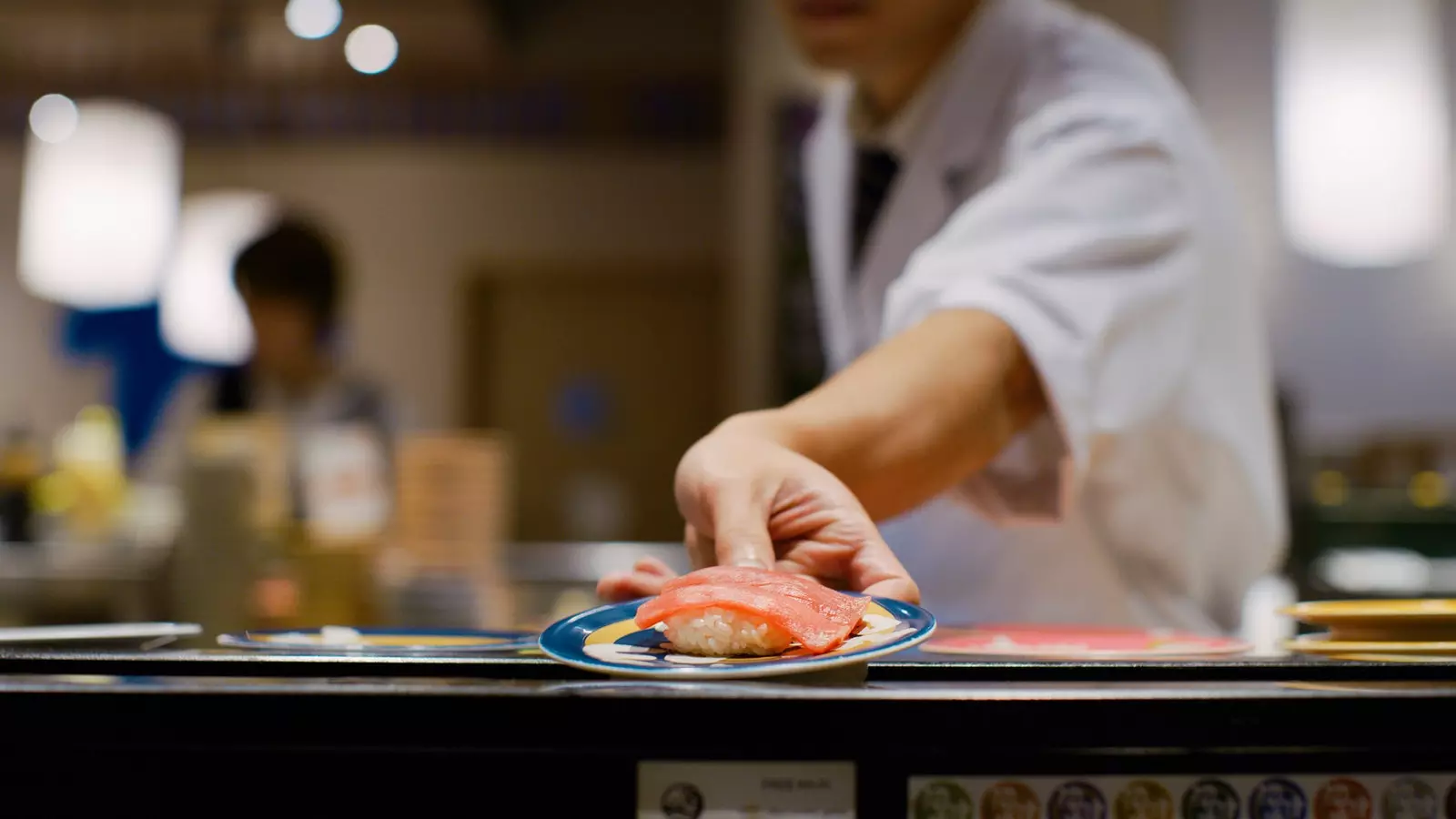
Solitary Gourmets (Part II)
I usually meet up with Hajime-san after a strenuous day or after one of those days when it wouldn't take too much effort to throw ourselves into the jaws of a colossal sandworm from Arrakis.
Hajime regularly comes to our "gastronomic therapies" still wrapped in his battle dress: shirt, tie and jacket on which he wears a pin with the flag of Japan. immaculate and ceremonious , despite the fatigue that slightly inflames his lower eyelid, he is extremely willing to indulge in one of the rituals that causes the most satisfaction to any human being in his right mind: eat well.
Our first stop is inexcusable and leads us to the financial center of the capital, a ten-minute walk from the Japanese Embassy in Spain itself and, precisely, to one of the favorite places for its workers for meetings or celebrations both official and unofficial.
1.** MIYAMA CASTELLANA (Paseo de la Castellana, 45) **
"If I have to take someone to a Japanese restaurant, the first place I think of is the Miyama Castilian . At least at present I do not know of any other option that guarantees me the 100% 'Japanese experience' ", Hajime assures us. This Japanese resident in Spain since his earliest childhood, the country in which he grew up and in which he has forged his education, has never lost sight of any of the idiosyncratic aspects of his nation of origin. Great connoisseur of the history, politics, culture (including the popular one, how could it be otherwise if we refer to one of the countries that has most successfully managed to export its characteristic cultural products internationally) and Japanese cuisine.
The Japanese who live outside of Japan do not usually happily expose themselves to the artifice in terms of gastronomy of their land. "It's one of our great fears: where can I find an 'authentic' Japanese restaurant? "Hajime tries to summarize for us the two characteristics that make Miyama Castellana his favorite place. On the one hand, the very high freshness and quality of its products , in whose scrupulous selection one of the fundamental concepts intervenes to understand, not only traditional Japanese arts, but Japanese thought itself applied to different facets: seasonality . "We are not only talking about seasonal products, but about a very important aesthetic and symbolic issue."
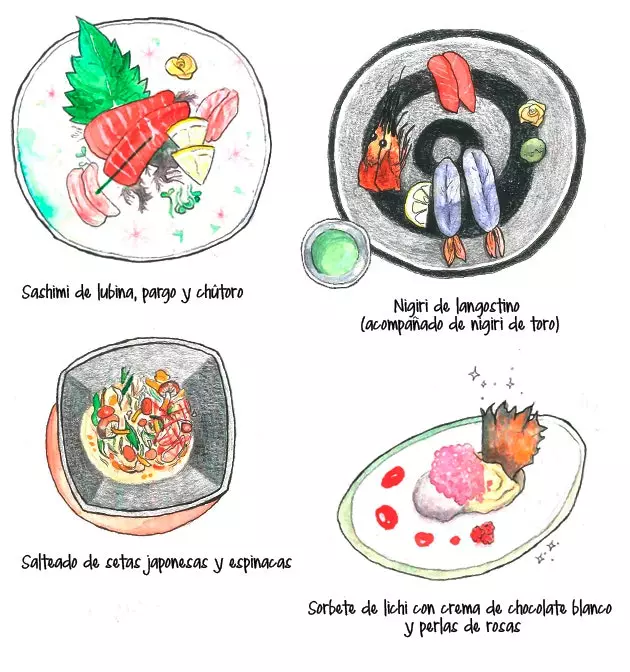
miyama
Secondly, impeccable table service by the maître and prestigious sommelier Hiroshi Kobayashi , whose particular training between Japan and Spain has made him a great connoisseur of both cultures. "Mr. Kobayashi knows the Japanese and Spanish temperament perfectly , so that he is able to organize a table service under the standards of Japanese rigor while managing to maintain a close relationship with the client. He is this Spanish or Japanese client ".
The "seasonality" It was perfectly reflected in two of the dishes that we were able to enjoy within the tasting menu that the establishment offered us. Japanese mushroom and spinach stir fry , starring this characteristic element of the autumn season, included three Japanese varieties in whose conjugation an exquisite gradation of texture and intensity of flavor is produced: shitake, shimeji and enoki. The combination in its base of the broth _ dashi _ with a touch of butter and soy is a real success . The sea bass, snapper and chûtoro sashimi was presented to us on a delicate ceramic plate dotted with maple leaves, evoking the autumn season with its chromatic choreography.
"There is an expression in Japanese called I taberu, which literally means 'eat with the eyes' . And in this sense, for the Japanese it is very important to take care of the presentation of the dishes, in the same way that we carefully take care of the wrapping of a gift depending on the occasion". Hajime politely gives me the appreciated aromatic shiso leaf on which rest the pieces of chutoro . However, we both agree that we find shiso much more interesting in tempura and we prefer that the tuna reaches our palate without intermediaries.
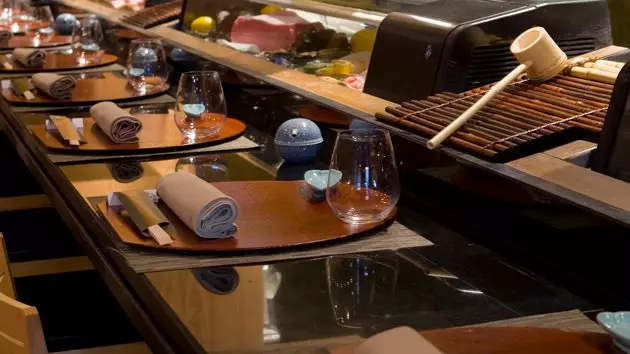
Table service is impeccable.
Another essential aspect that Hajime highlights within the appreciation of gastronomy by a Japanese is the importance of the contrasts established between hot and cold dishes ; between raw elaborations and cooked, fried, grilled elaborations... For this reason, the selection of Miyama bentô, a possible tasting menu that this restaurant offers on the menu, it seems very interesting.
" In Japanese cuisine we have to forget about the concepts of first course, second course and dessert . In the same way that a ryokan (traditional Japanese inn) offers its guests a menu that could be described as a journey through flavors and textures , I find that in this corner of Madrid that concern for filling the diner's stomach in an intelligent, gradual way." Hajime explains that, in Japanese, there are two very curious concepts in terms of tasting. Nodogoshi would refer to the sensation of a substance going down the throat and shokkan It is directly related to the palate, referring to the texture of the food itself in its interaction with the previous one.
And in this range of textures, two dishes especially call our attention. The generous shrimp nigiri (accompanied by bull nigiri) are served by combining two radically different preparations. The fleshy and bluish body rests raw on the rice, contrasting with the salty hatching of the head, which is fried, the perfect complement that does not miss a single fragment of the crustacean. To end, a delicate and magical dessert . The name of our fairytale: lychee sorbet with white chocolate cream and rose pearls . In this sensual dish, the almost ethereal lychee sorbet rests on a creamy bed of white chocolate and cream, accompanied by an entourage of pink water pearls, natural raspberry and red fruit jam. All this is crowned by a caramelized shiso leaf, which we must crumble over the entire combination to enhance its freshness.

And this, gentlemen, is a chromatic choreography
2.**HANAKURA (Murillo Street, 4, Olavide Square) **
Every good gurume is humble in spirit; faithful and sincere before the simple (and extremely intelligent) conviction that "If something is good, it will be because it is good" . Hajime san has this expression tattooed on his chest (eye, metaphor, let's not skid associatively) or, rather, on his palate, convinced that exacerbated "purism" never leads to happiness. Thus, he is never daunted by a "tempurized maki" , the man with the battered sack that frightens the most conservative guardians of tradition, much less in the face of the glorious and comforting cuisine that comes out of the town's kitchens. In this case, from teppan ( , steel plate).
The Hanakura, pioneers in the elaboration of okonomiyaki in Madrid , we are ready to taste the star dish of the house. The term okonomiyaki ( ), from the family of modest and tasty konamono **("things with flour") **, means something similar to "grilled elaboration to the taste of the consumer". And it is that the paths that lead us to the also known as "Japanese pizza or omelette" they are full of endless possibilities. One could add ingredients to this typical dish from the Kansai and Hiroshima region until their choice becomes a kind of absolutely delicious **Marjory The Trash Heap**.
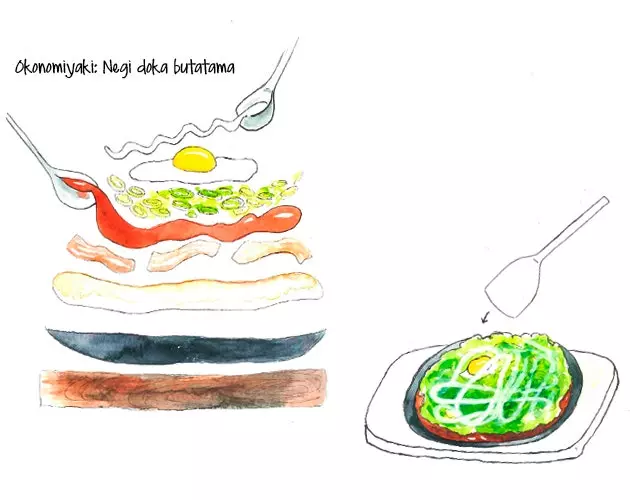
Hanakura
Although in the case of Hanakura the options are obviously much more restricted than if we delve into the fascinating _ Okonomimura _ ** from Hiroshima **, the proposals included in their menu meet Hajime's expectations, who ends up captivated by the negi doka butatama , starring pork, refreshing chives (negi) that will facilitate our digestion and a crown of eggs, kewpie-may (Japanese mayonnaise) and sauce okonomiyaki (also interchangeable for tonkatsu sauce) . We can summarize the keys to a good okonomiyaki in three concepts:
- A good balanced dough of flour wheat, egg, water and dashi.
- The quality, the cut and the correct preparation of the pork meat. If the strips are too thick, oily, hard or underdone, the disaster can be huge. (We are talking about the butatama variety, with pork).
- A generous daub , almost childish, in the sauces.
Hajime uses the essential metal spatula or trowel (kote) with grace and precision, dissecting the steaming hodgepodge appropriately. And the result satisfies: juicy, tender and very tasty. The dish evokes in Hajime an endearing imagery of family and domestic memories. We are left with some wise advice from his father: if you ever embark on the adventure of homemade okonomiyaki, never use the same griddle on which you make ordinary pancakes. Or all the _ kami _ will cry in unison and your existence as mortals will be terrible.
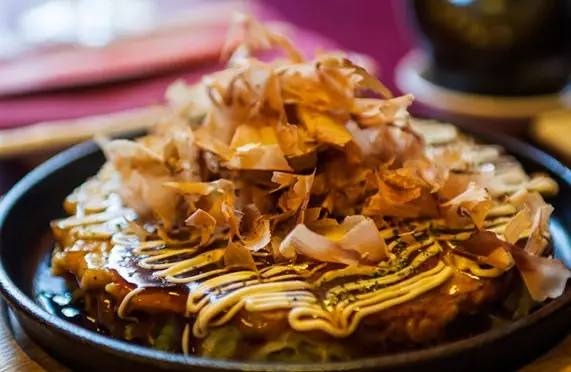
Try their delicious Okonomiyaki
3. HIMAWARI SAKE DINING _(Calle de Tamayo y Baus, 1) _
Faced with the innocent question, "where could we have a good sake?", Hajime leads us to a cozy corner of wood and bamboo in front of the María Guerrero theater. Himawari has **an overwhelming and marvelous offer of nihonshu** ( ) and other Japanese liquors, which preside over the place forming a beautiful border of bottles of different shapes and colors.
Among the infinity of existing options, a name captures the attention of our gurume , concentrated on each of the descriptions of the letter. Far from breaking your head with the possible rules of pairing, Hajime pulls instinct and originality and, after a bloody battle with his inner self in which we can see how terms like Yamadanishiki, Junmai, Daiginjo... fly over his head, our lanky diner opts for a curious proposal: "Let's have nigori, sweeter and interesting in texture. Cold, of course." So before us appears a beautiful opaque green bottle of Gekkeikan Nigori . The fluid guarded inside, cloudy, creamy, lactic, is the result of the decision to preserve some rice sediments during the filtering process.
We chose as a spontaneous pairing some mammoth flambéed tuna belly nigiri , exuding the happy fat like fever, on his bed of bamboo leaf. Topped with fresh wasabi: "The key is to mix the finely chopped leaves with the grated root. My father loves it. As you can see even with the naked eye, there is no comparison with a paste of **industrial wasabi powder** ". Well no, dear Hajime. There is no color.
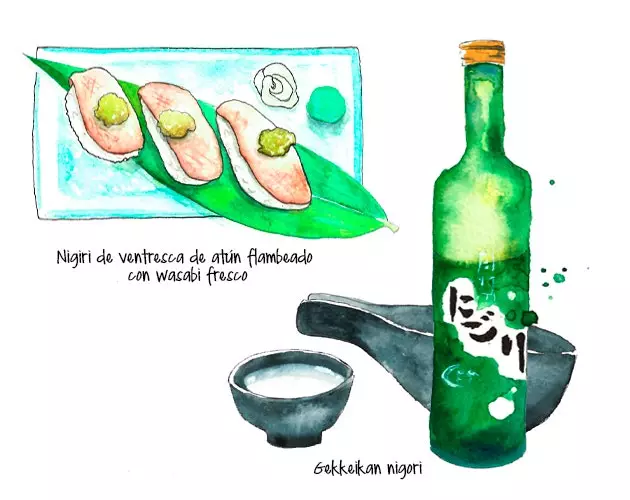
An overwhelming and portentous offer of nihonsu (sake)
4.**IZARIYA (Zurbano Street, 63) **
One of the main obsessions of the Japanese gurume is inevitably related to the basic and primordial food of the Japanese diet: rice . "According to the words of chef Masahito Okazoe, owner of the Izariya, in his establishment the cooking of the rice is taken care of with care, respecting the degree of humidity and the appropriate texture . It is very important to remove the rice from the 'rice cooker' at the exact moment and let it cool down outside of said container to avoid overcooking and causing the grain to cake. Just as important is to give it back the precise temperature before serving it to the diner ".
Hajime is relentless in his scrutiny of the grains of **sushi meshi ( ) or shari ( ) ** (rice prepared for making sushi). For this reason, he considers that the fourth establishment, the first outside of Japan, of the Master Okazoe is a more than appropriate place to delight (in addition to sophisticated Japanese haute cuisine tasting menus or kaiseki ryori , closely linked to the concept of "seasonality" that we handled when talking about Miyama) with one of the dishes available on the menu that is offer from Monday to Friday: the chirashi-zushi : sushi rice with garnish (chirashi means "spread") from tuna, eel, squid, salmon roe, vegetables and tamagoyaki (Perseverance and despair are usually delimited by a thin line, by the way...) .
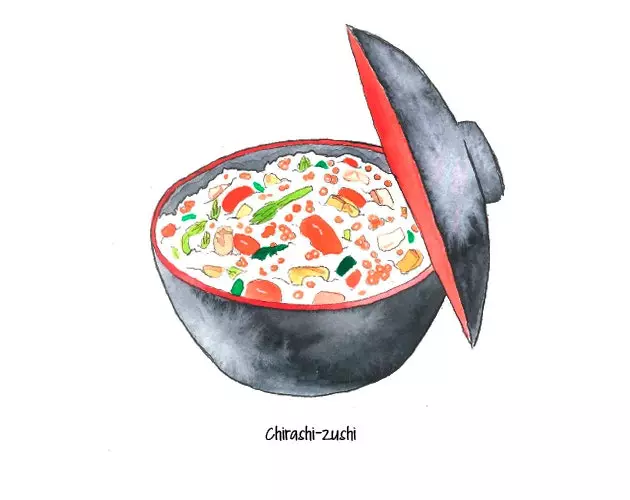
Or rice perfection
5. TXA-TEI _(Don Ramón de la Cruz Street, 49) _
The possibility of experiencing the warmth of home in the stomach and that the taste buds vibrate with nostalgic recreation can be fully compatible with refinement . A clear example of this is Txa-Tei, where we can find dishes as simple and hospitable as agedashi tofu, Iberian pork harumaki with mashed potatoes or the supernatural tofu and crispy homemade chips, along with more sophisticated preparations, "no shrillness or complications" . On this occasion, we enjoyed two of their star dishes, the bull tataki and the spicy tuna tartare with tobiko (flying fish roe) and fried garlic, along with a gradual tasting in the form of an epic triad: sashimi of toro_, chûtoro_ and ôtoro, the different parts into which the tuna belly is divided depending on the level of fat (the chûtoro being generally the most appreciated for its balanced combination) . Bull therapy works, folks.
Follow @Lmazab
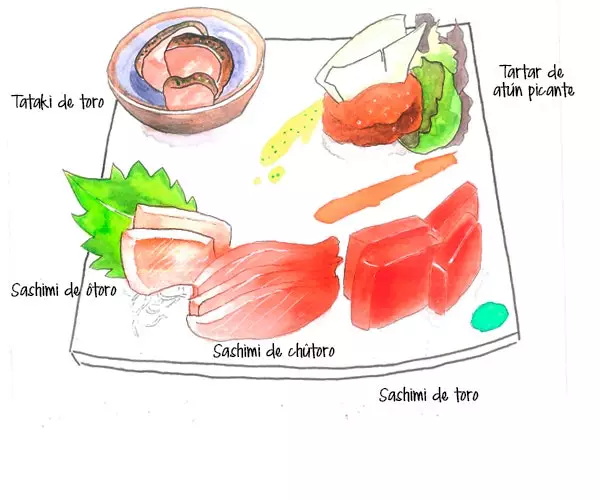
Experience the warmth of the Japanese home at Txa-Tei
